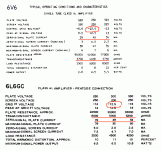Look at the curves. At 300V B+, 300V screen, 70 mA, about 20V. But pentode connection would require a decent amount of gNFB, and Schade connection (like RH807) requires increased drive voltage due to the local negative feedback.
Look at the curves. At 300V B+, 300V screen, 70 mA, about 20V. But pentode connection would require a decent amount of gNFB, and Schade connection (like RH807) requires increased drive voltage due to the local negative feedback.
Help me understand. The RH807 drives the 807 with the same 12AT7 with similar plate resistors on the driver. Why is the drive sufficient on the RH807 but not the El Cheapo. Wouldn't the LTP gain be similar to the RH807 gain?
It's not sensitivity per se...
But that's not what you said earlier:
The baby huey / el cheapo / musical machine topology only works well with a high sensitivity tube like the el84...
I'm not picking on you. My point is that we have here a wildly diverse audience, in terms of knowledge and understanding. So the novices may take advice at face value, without the context assumed by the more knowledgeable. Therefore it's important to be careful both giving and taking advice.
So to the OP, my advice remains: If you don't have the knowledge to design it yourself, it's best to copy exactly something proven. Otherwise you're experimenting at your own expense.
If you don't have the knowledge to design it yourself, it's best to copy exactly something proven. Otherwise you're experimenting at your own expense.
Great advice!
Which I probably won't follow. (I am pretty good with LTspice though....🙂)
LTSpice is an excellent way to experiment at no expense. You can change things and see what happens. You can learn a lot from that.
LTSpice is an excellent way to experiment at no expense. You can change things and see what happens. You can learn a lot from that.
Yes I have modeled the RH807 with it. It won't tell me how it sounds but I can get the DC op points right and get the gains right (I think). But I need to start from a proven design and then tinker with it.
Hi jderimig, off topic but I'd appreciate the RH807 schematic if you have it. I see references all over the place, but never the schematic.
Hi jderimig, off topic but I'd appreciate the RH807 schematic if you have it. I see references all over the place, but never the schematic.
Here is the post with the schematic on it (from a thread on my project).
https://www.diyaudio.com/forums/tubes-valves/359327-amp-dads-tube-stash.html#post6321415
From a quick glance at the datasheets the 6V6 gm ~4000, the 807 is ~6000. If these number are correct does this mean the 807 has higher sensitivity than a 6V6? Or do I have this backwards?
The two numbers are at *different* current (right?).
Gm always increases with current.
Also with cathode area. (And plate current is a design factor on heater power.) The double heater power on 807 suggests higher Gm but it is not twice as high. In fact not radically different.
Attachments
The two numbers are at *different* current (right?).
Gm always increases with current.
Also with cathode area. (And plate current is a design factor on heater power.) The double heater power on 807 suggests higher Gm but it is not twice as high. In fact not radically different.
That was my point/question. If a 6V6 could be driven by the circuit then a 6L6 family tube (807/1625) should be as well?
Unless you are doing something super unusual, read the data-sheet drive conditions and see what the drive voltage (and all other!) values are.
I know we are all locked-in/down and bored out of our gourds. But back-figuring drive from Gm from unstated loading assumptions is not a good use of excess energy.
I know we are all locked-in/down and bored out of our gourds. But back-figuring drive from Gm from unstated loading assumptions is not a good use of excess energy.
But back-figuring drive from Gm from unstated loading assumptions is not a good use of excess energy.
I'd never do that but I would simply see if one tube MIGHT behave in the same ballpark as another tube. If the same ballpark is indicated then I would go to a Spice simulation. This is the equivalent of video gaming for 60+ y.o. nerds.
Yes, your thinking is correct. If the tube you choose has enough gain (gm or mu), it's a starting point. Just build the amp in LTSpice and play with it and see what happens. The main difference is that the amp was designed for a 12W final tube and you are introducing a 25W final tube. So expect a lot of changes in the operating conditions, PS, OPT, etc.
- Home
- Amplifiers
- Tubes / Valves
- Mullard 5-10 input stage needed?
